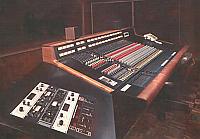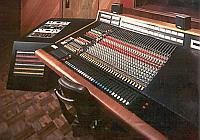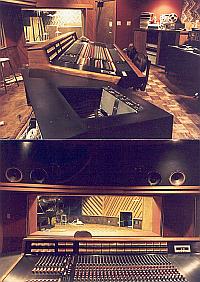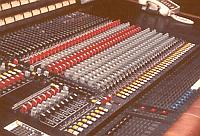CUSTOM 32x24 RECORDING DESK
Designed/Built by Brian A. Roth 1977-78
 1 1
 2 2
 3 3
1. View from left (note theSpectrasonic and UA limiters!)
2. Another view.
3. Other snapshots.
This desk, built in
1977/1978, was a very ambitious project for a 23 year-old "kid", but I had a passion
for excellent performance and construction quality. The desk was delivered in
early 1978 to Maranatha Studios in Santa Ana, California, and remained in use for
about a dozen years. I understand that some/all of the desk has been reinstalled
in another SoCal studio.

A more close-up view of the control surface.
Overall design concepts.
The signal flow was a
mixture of MCI "inline" design with ideas borrowed from API, Neve, and others.
There were only eight program mixing busses (not counting stereo mix, echo sends, etc.),
BUT each I/O module had a "D" (Direct) switch that connected the I/O channel signal
directly to the corresponding multitrack input. If the "D" switch was not
activated, then the output of a submaster was routed to the multitrack input.
Since most multitrack recording consists of one mic source on one tape track, this "D"
method eliminated a lot of extra circuitry in the signal path.
My mic preamp design
was an interesting beast. In the "non-padded" mode, the microphone fed into a
Jensen 115-KE transformer. When the "-20 dB" switch was flipped, the Jensen was
replaced by a unity gain differential amplifier.
The EQ section had a
sweepable 12 dB/octave low-cut Bessel filter, adjustable from 25 Hz to 350 Hz.
The low and high frequency EQ sections were switchable between shelving and peaking.
Continuous sweep range for the LF section was 45 to 350 Hz, and the HF was 1.7
to 15 kHz. The mid band was a fully parametric section, tunable from 100 Hz to
1.6 kHz or 1000 Hz to 16kHz (selected via a "F x 10" switch), with bandwidth adjustable
from 2 octaves to 1/3 octave. The low cut and EQ sections were totally "hard wire
bypassed" when not needed. Thus, it was possible for only two opamps and their
associated components to be in the signal path when no EQ was required, and with the "D"
switch activated instead of using a submix buss.
In order to minimize phase
shift in the audible passband, my design goal was for a -1 dB point at 75kHz on the top
end (exception: when the Jensen tranny was in circuit, the -1 point moved down to 40
kHz), and approximately 10Hz for the bottom -1 dB point.
Each module had an overload
peak detector that sampled all gain stages, so that (hopefully!) no combination of
screwball level or EQ settings could cause a clipped signal without the red LED on the
channel strip lighting up. The solo sends were taken after the pan pots, so non-
destructive stereo "solo-in-place" was available. Every solo switch had an associated
lamp or LED, so it was easy to find what paths were soloed.
To show what era this console
was from, it had only had four echo/effects send busses. A dual concentric send pot fed
two sets of four echo buss selection switches. Two cue sends were also available, and
could be used as additional post-fader effects sends during mixdown.
Components and mechanicals.
The faders were expensive
100-mm-throw P&G's (with the multi-pin connectors on the rear) and rotary pots were
custom-ordered Bourns conductive-plastic 5/8" square devices. It may not be
immediately apparent from the blow-up of a 5x7" photo, but I used a LOT of concentric
pots in order to make the panel space more compact. Speaking of which, the knobs
were from Rogan; these all had dual hex key setscrews to attach them to the pot shaft,
something you don't see much of anymore.
The square white (channel
mute) and yellow (solo) illuminated pushbuttons above the faders were Swiss-made EAO,
a brand that has shown up in some Otari and MCI recorders. The remainder of the
pushbuttons were gold contact Schadow switches, and the mini toggle switches were gold
contact C&K's.
The meters were the same
model Dixson meters that Ampex used on the AG-440 "A" and B series recorders, but with
a twist. I added a LED "peak winkie" onto the dial face of each meter, borrowing
the concept from Tascam's mixers of that era. The threshold of the LED peak detector
was adjustable, and I calibrated it to correspond to the midrange saturation level of the
tape on the studio's Stephens 24 track recorder.
Now, onward to the
internals. I used the then-brand-new NE5534 opamps throughout. All resistors
in the signal path were metal film. Capacitors for filters, EQ, etc. were
tight-tolerance polypropylene or polystyrene models. Several sealed reed relays
were in each module to perform various signal switching operations.
A steel "tray" attached
to the front panel acted as support for the four PC boards that made up each I/O module.
I borrowed an idea from Neve consoles from that era(although I reversed the genders)
and used a gold plated male connector from Amphenol on the module in lieu of the more
common "edge connector", and it mated with a female edge connector in the mainframe.
The patchbay seen in the
"Another view" link above was custom fabricated. A single slab of black phenolic was
machined to accept the Switchcraft long-frame jacks.
The wood trim was solid Teak
wood, and yes, that is "gen-u-wine" leather covering the wrist rest. The Ampex ATR-100
remote control was built into a panel on the left end of the console.
Power supply.
I put a lot of thought into
the design of the power supplies. On one hand, I needed to accomodate low AC Mains
conditions, yet I wanted to avoid excessive heat dissipation if using high "raw" DC rails
into the regulators. After some agonizing, I finally decided to use three
Acme Electric ferro-resonant bulk DC supplies to provide fairly well-regulated 24 volts
DC sources, regardless of AC mains variations. These fed electronic regulators mounted
under the right-hand "producer's desk" seen in the photos, so the final voltage regulation
was performed inside the actual console frame.
Well, that's all I can think
of regarding the console. It was one helluva construction project! I hope you
enjoyed the tour.
Contact me!
My shop is set up to do all
manner of from-scratch audio projects, from design to installation. I've done everything
from this console to building a multitude of studios and multi-media presentation theaters,
as well as modifying vintage gear into "rack-up" boxes for an outboard rack.
By the way, I still have all my plans for this desk, and I can make custom channel strips
or other "rack-ups" based upon my modules. Contact me and we can discuss your specific needs.
Plus, I'm always available to assist with any professional audio "issues" you might have in
your studio.
Contact info:
Email:
Brian@BrianRoth.com
Cell/voicemail/pager:
405-630-7509
Return to RothTech Main Page
|